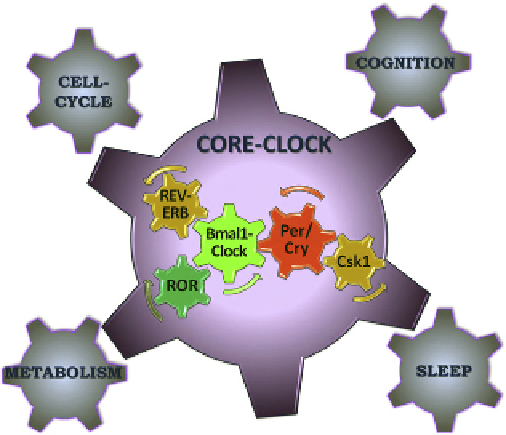Biology Reference
In-Depth Information
Mammalian Per genes seems to be the exception to this
rule. Per1
-/-
, Per2
-/-
and Per1/Per2
-/-
mice display normal
sleep architecture and rebound following sleep deprivation
[69,70]
. Interestingly, in rodents and humans the Per3
isoform, a 'redundant' component of the clock, has been
discovered to have a stronger role in sleep homeostasis than
its more celebrated siblings. Humans homozygous for
a naturally occurring polymorphism in the Per3 locus
(Per3
5/5
) had comparatively higher sleep pressure and were
more susceptible to the effects of sleep loss
[71]
. Follow-up
studies in Per3-mutant mice recapitulated some of these
phenotypes
[72]
. Additionally, carriers of spontaneously
occurring point mutations identified predominantly for
their circadian deficits were subsequently also found to
have sleep
e
wake disorders. For example, in 1999, the
Pt
´
cek group first published the identification of a circadian
disorder in humans called familial advanced sleep phase
syndrome (FASPS;
[73]
). As the name suggests,
the
FIGURE 21.2
The circadian clock is a gear within a much larger
machine. The core clock comprises interlocking feedback loops of
transactivators (Bmal1/Clock) and transrepressors (Per/Cry) that are
regulated at the transcriptional level by nuclear hormone receptors
e
RORs and REV-ERBs
e
and at the post-translational level by casein
kinase 1 (CSK1) to produce rhythmic output with a 24-hour period. This
core clock is represented as a cog among many that together comprise the
physiological machinery of an organism.
sleep
wake rhythms in FASPS patients are phase advanced
[73]
. Subsequently, Pt´
e
cek and Fu's group identified that
the syndrome is caused by a point mutation in hPer2
[74]
or
by a T44A missense mutation in the enzyme casein-kinase
1
d
(CK1
d
;
[75]
). CK1
d
and CK1
are already known in the
field of circadian biology to be involved in turnover of the
PER proteins and to drastically affect the circadian clock in
behavioral assays
[76
ε
79]
.
Another example, Dec2, a basic helix
e
Clock/Npas2) and two families of transrepressors (Per1/2/3
and Cry1/2) (see
Figure 21.2
;
[56,57]
). Drosophila and
mouse models have been made for all of these components,
and sleep has been characterized in many of them. Cry1/
Cry2
-/-
double-knockout mice display a longer and, more
consolidated NREM sleep with higher
d
power than wild-
type littermates
[58]
. In other words, sleep analyzed in
Cry1/Cry2
-/-
double-knockout mice, which are behavior-
ally arrhythmic, resembled EEG recordings from wild-type
mice following sleep deprivation. Similar disruption of
sleep homeostasis has been reported in other clock-mutant
mice (
Table 21.1
), emphasizing the strong relationship
between these two critical processes.
helix
(bHLH) protein that is thought to repress Clock/Bmal1, is
conserved between mice and humans and a related ortholog
is present in flies
[80,81]
. Although neither Dec1 nor Dec2
knockout mice have circadian locomotor activity deficits,
they do respond poorly to light pulses
[82]
. Recently Fu's
group identified a point mutation in Dec2 (P385R) in
humans associated with short sleep. Most humans need
about 8 hours of sleep per night, two individuals carrying
this Dec2-point mutation need only 6 hours per night
[83]
.
Although many people may feel as if they only need 6
hours of sleep, the majority will suffer attention deficits
after only one or a few days of 6-hour sleep
[28]
. In mice,
loop
e
e
TABLE 21.1
Status of Sleep Homeostasis in Clock-Mutant Mice
Knockout(gene)
Wheel running
Sleep homeostasis effect
Reference
Clock
Rhythmic
NREM time and consolidation;
REM after sleep deprivation
[59
61]
Y
Y
e
Bmal1
Arrhythmic
[
Total sleep;
[
fragmentation;
Y
SWS;
Y
rebound sleep after sleep deprivation
[62,63]
Npas2
Rhythmic
Y
NREM time in dark-phase;
[64
e
66]
Dbp
Rhythmic
Y
NREM time and consolidation;
Y
REM after sleep deprivation
[67,68]
Per1-Per2
Arrhythmic
No change in Waking, NREM, REM; No difference in rebound sleep
[69,70]
Per3
Rhythmic
Y
Wakefulness,
[
REM,
[
NREM
e
in light phase;
Y
REM,
Y
NREM time in dark-
[70,72]
phase;
Wakefulness,
REM
after sleep deprivation
Y
[
e

























